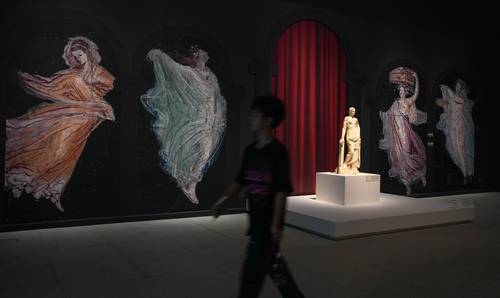Endangered species are recreated with Huichol art.

Endangered species are recreated with Huichol art.
▲ Among the 17 pieces in the Murmurs of Nature exhibition, the most notable is a 6-meter sculpture of a hippopotamus, whose hooves and tusks alone weigh 300 kilograms. Photo courtesy of BBVA Mexico
Daniel López Aguilar
La Jornada Newspaper, Thursday, July 10, 2025, p. 5
With the meticulousness of a craftsman and the deep gaze of a committed observer, César Menchaca (Mexico City, 1967) calls for an urgent dialogue with the environment through Murmurs of Nature .
The exhibition, which opens today at the BBVA Tower, brings together 17 pieces representing endangered species, integrating the ancient tradition of Huichol art, and simultaneously reflecting on the current environmental crisis.
Five large sculptures occupy the main space, the result of seven years of collective work involving nearly 300 artisans from Wixárika and mestizo communities, from Puerto del Guamúchil, Durango, to neighborhoods like Martín Carrera in Mexico City, Menchaca's hometown.
One of the most striking pieces is the rhinoceros, whose crystals gleam like a cloak of hope and fragility. Its hooves, plated in bronze and gold, symbolize the courage and threat the species faces.
The shining horn is a cry and a murmur that speaks of human greed and the urgency to preserve what remains
, the artist explained in an interview with La Jornada .
The 6-meter-long hippopotamus opens its enormous jaws as if conveying an ancient message. Its hooves and tusks, which alone weigh 300 kilos, lend solemnity to the figure.
The turtle, suspended in the air, was created from plastics recovered from the sea, which were patiently shaped into a shell embroidered with Wixaritari iconography, and a reminder that the oceans generate 70 percent of the oxygen we breathe.
A flamingo stands out for its elegance, a symbol of balance and harmony, whose feathers recreate beads placed one by one by native artisans, in a process that combines precision and an intimate connection with the environment.
Near these monumental sculptures, smaller pieces tell other stories: a soccer ball made from recycled plastic that unites identity, sport, and environmental awareness; the xolo, an ancient dog that serves as a bridge between the tangible and the spiritual; and the blue hippopotamus, which in the Wixaritari worldview symbolizes the power of the earth and the flow of water.
The installation is a chorus of voices that seeks to awaken empathy toward nature in those who visit it. Every bead, every crystal, every fragment of reused plastic represents a pulse of resistance and memory
, Menchaca noted.
“This dialogue is built on respect for Huichol tradition, where key iconographies, such as corn—a symbol of abundance—peyote—a source of wisdom—and the deer—elder brother—are intertwined with contemporary techniques.
Collaboration with artisans creates a bridge where the hands of Indigenous peoples coexist with mixed-race skills, giving life to works that defy time and material limits so that art endures.
When they began working with ocean plastics almost a decade ago, they faced pushback against these materials. No one wanted to link art with trash, but the intention was clear: to bring visibility to the problem and generate a call for change
, the sculptor added.
During the process, technical and conceptual advances were achieved, such as replacing traditional Campeche silk with a special resin that guarantees durability without sacrificing the artistic essence.
César Menchaca recognized the collective effort: Nearly 50 Wixaritari artisans, along with several mestizos, brought every detail to life
.
The tour also highlights the strengthening of communities linked to art. In Puerto del Guamúchil, where three pioneering artisans began, more than 600 now preserve this tradition, largely thanks to projects promoted by the artist.
This series is presented as a visual chronicle of a world in crisis, interweaving culture, ecology, and resistance.
It's no coincidence that a soccer ball opens a window into the near future, with the 2026 World Cup being held in Mexico. This symbol stands as a universal language that unites voices and connects popular culture with environmental awareness.
I hope everyone will look closely and listen to the murmurs that often go unheard. We are part of the problem, but we can also be part of the solution. It is essential to recognize the damage caused and promote education about plastics, recycling, and biodiversity conservation
, Menchaca said.
Organized by Fomento Cultural BBVA México and Menchaca Studio, Murmurs of Nature can be visited Monday through Friday, from 9 a.m. to 7 p.m., at the BBVA Tower (Paseo de la Reforma 510, Juárez neighborhood, Mexico City). Admission is free.
jornada






